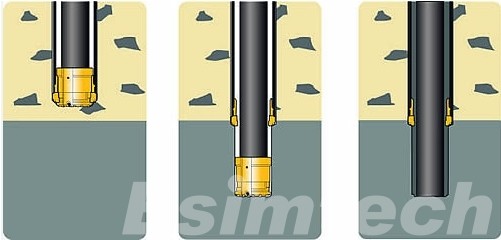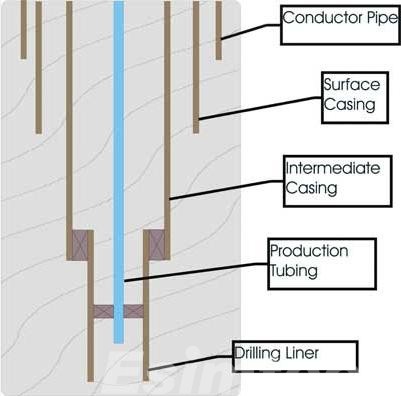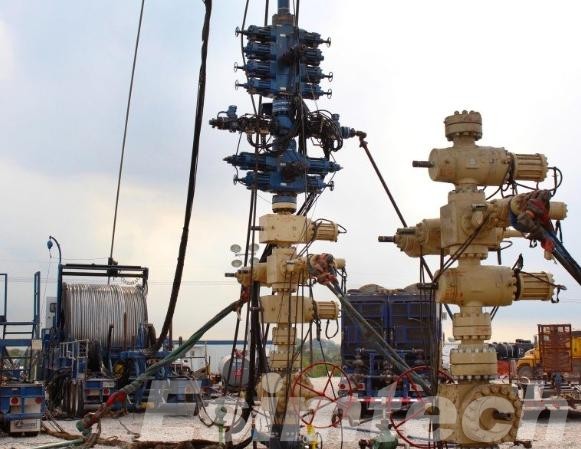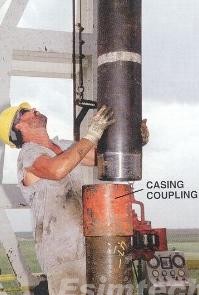Understanding the Different Types of Casing Used in Drilling
Casing plays a vital role in the success of an oil and gas well. It acts as a steel backbone, ensuring wellbore stability, preventing fluid migration, and protecting against formation pressure. But with various types of casing available, choosing the right one for each well section is crucial. This article explores the different casing types used in drilling and the factors affecting their selection.

Types of Casing in Drilling
There are five main types of casing used in oil and gas drilling, each serving a specific purpose and designed with unique properties:
- Conductor Casing: Nicknamed the “shoe” because it resembles one, the conductor casing is the first line of defense for a well. Installed with a large diameter, typically ranging from 16 to 30 inches, it protects the wellhead from shallow, unconsolidated formations like loose soil and sand. Conductor casing also facilitates the initial drilling process by providing a stable platform for subsequent drilling operations. It’s often driven into the ground before the drilling rig arrives, signifying the official start of well construction.
- Surface Casing: Drilled deeper than the conductor casing, typically between 9 ½ to 20 inches in diameter, the surface casing safeguards against unstable formations encountered during drilling the surface hole. This casing string protects freshwater resources from contamination by drilling fluids, which are essential for lubricating the drill bit and carrying cuttings to the surface. Surface casing also provides a strong foundation for installing the blowout preventer (BOP) stack, a critical safety equipment that controls well pressure during drilling operations.
- Intermediate Casing: Often the workhorse of the wellbore, the intermediate casing string can be the longest, ranging from 7 to 13 ½ inches in diameter. It’s designed to isolate zones with high pressure or potential formation instability. This casing allows drilling to proceed through challenging formations like pressured shales or fractured rock before reaching the target production zone. Intermediate casing selection is crucial for wellbore stability as it ensures the wellbore can withstand the forces encountered during drilling deeper sections.
- Production Casing: The final casing string run before production begins, the production casing acts as the gateway to the reservoir. Installed with a diameter typically between 5 ½ to 9 ½ inches, it isolates the reservoir zone from the wellbore and provides a conduit for oil and gas to flow to the surface while preventing unwanted fluid migration from surrounding formations. Production casing needs to be robust enough to withstand the pressure and corrosive nature of the produced fluids over the well’s lifespan.
- Liner: Similar to casing but typically not run all the way to the surface, liners offer a more cost-effective solution for isolating specific sections within a wellbore. They are often used in conjunction with intermediate casing, extending wellbore protection deeper into the well. Liners come in various diameters, typically ranging from 4 ½ to 7 inches, and can be hung from the bottom of the intermediate casing using a liner hanger. In liner completions, both the liner and the intermediate casing function as the production string. Liners are particularly useful when targeting multiple production zones within a well or when isolating a specific interval for enhanced production.
By understanding the distinct functions and properties of each casing type, engineers can select the most suitable combination for a safe and efficient drilling operation.

Factors Affecting Casing Selection
Choosing the right casing for each well section is a complex engineering challenge that requires careful consideration of several key factors. Here’s a deeper dive into how these factors influence casing selection:
Well Depth and Target Formation
- Depth: As well depth increases, the weight of the overlying rock formations creates greater pressure on the wellbore. Casing needs to be strong enough to withstand this collapse pressure. Deeper wells often utilize multiple casing strings with progressively smaller diameters, each designed to handle the specific pressure at its depth.
- Target Formation Pressure: The pressure of the oil and gas reservoir is another critical factor. Casing needs to be able to contain this pressure and prevent blowouts – uncontrolled releases of fluids from the well. Understanding the anticipated reservoir pressure through geological studies helps determine the required burst strength of the casing.
- Formation Strength: Formations with low strength, such as unconsolidated sands or fractured rock, pose a high risk of wellbore collapse. Casing selection considers the formation collapse gradient to ensure the casing can maintain wellbore stability.
Formation Characteristics
- Presence of Corrosive Fluids: Some formations contain fluids rich in hydrogen sulfide (H2S) or carbon dioxide (CO2) that can corrode steel casing over time. In such cases, corrosion-resistant casing materials or special coatings are necessary to ensure long-term well integrity.

- High-Temperature Formations: Deep wells or those targeting geothermal resources encounter high temperatures. Casing needs to be resistant to thermal expansion and maintain its strength at these elevated temperatures. Selecting casing with the appropriate thermal properties is crucial.
Drilling Fluid Properties
- Mud Weight: The weight of the drilling fluid used to control well pressure and maintain wellbore stability plays a significant role. Casing needs to be able to withstand the hydrostatic pressure exerted by the drilling fluid at its set depth.
- Compatibility with Drilling Fluids: Certain drilling fluids may contain chemicals that can react with the casing material, compromising its strength. Selecting casing with chemical compatibility for the chosen drilling fluid system is essential.
Expected Production Rates
- Production Volume: The anticipated volume of oil and gas produced from the well dictates the size of the production casing. A larger diameter casing allows for higher flow rates, but it also comes at a higher cost.
- Production Pressure: During production, the pressure within the wellbore can fluctuate. Casing needs to be designed to handle the expected maximum production pressure to prevent leaks or ruptures.
Cost Considerations
- Balancing Strength and Cost: While selecting the strongest casing might seem ideal, it’s not always the most economical solution. Engineers strive to achieve a balance between the required casing strength for wellbore stability and cost-effectiveness. Liners can be a viable option for specific well sections, offering a more cost-efficient way to isolate zones without compromising well integrity.
- Environmental Regulations: Regulatory requirements for casing design and materials are becoming increasingly stringent, particularly in environmentally sensitive areas. These regulations can influence casing selection by mandating specific properties or materials to minimize environmental impact.
By thoroughly evaluating these factors and considering their interplay, engineers can make informed decisions about casing selection for each well section. This ensures a wellbore that is safe, efficient, and optimized for its specific production goals.

Conclusion
Choosing the right casing is paramount in oil and gas well construction. Each casing type tackles specific challenges downhole, ensuring wellbore stability, safeguarding against formation problems, and keeping well economics in check. Through meticulous evaluation of wellbore conditions and production needs, engineers can select the optimal casing solution, paving the way for a safe and prosperous drilling operation.

